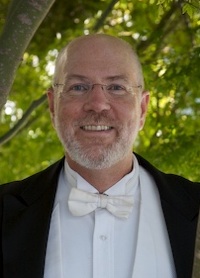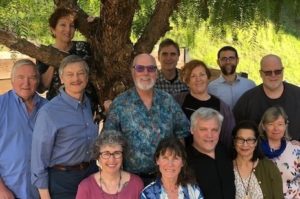Watery themes, sea of harmonies
Last weekend the North Star Vocal Artists presented an a cappella program on texts about water at three locations around the Bay Area: Novato, San Francisco, and Healdsburg. I attended the Saturday night concert at St. Gregory of Nyssa Church in San Francisco and enjoyed the lively and spacious acoustics of the main dome, where excellent singers sang unusual arrangements by contemporary composers.
Led by Sanford Dole, who is a composer and also conducts two other groups, this relatively new group of 15 singers was created to showcase a wealth of vocal writing from the 1980s to the present.
They opened with The Sounding Sea by Eric William Barnum on a poem by George William Curtis, a complex and effective vehicle for waves of sound and layers of voices to evince the powerful ebb and flow of water. It was “word painting” at its best, with complex harmonies that drew us deep and questioned the transparency of the mediums of sound and water, and had lovely crunches of half-steps and disturbing washes of sound.
Themes were sung by overlapping voices to create the regularity of waves crashing on a beach, and then we heard the hiss of foam, and long strange chords, and soft vowels closing to a hum.

They returned for Water: Making Everything New, which Sanford Dole was commissioned to write in 2010 to commemorate the 30th anniversary of the East Bay’s Pacific Mozart Ensemble, now known as the Pacific Edge Voices. Dole turned to us and introduced his piece. “It was first performed in the Hamilton Tower on a 100-acre estate, the Oliver Ranch in Geyserville. This [site-specific] artwork is a concrete silo by artist Ann Hamilton that is 80’ tall and 20’ across, with a pool of water inside the base and open to the sky. There are two stairways inside the wall, a double helix, and it was meant that the performers would enter and stand on one stair and the audience on the other…This piece is more minimalist for me with repeating motifs, a style I don’t normally write in.”
Using text by Native American writer Paula Gunn Allen, the fifteen singers created slow evocative chords, repeating “Water” in a mix of lush and punchy like the jazz chords of Manhattan Transfer. They shifted uptempo with brightly popped out words, the improbable names of water, and it was funny and showy. There was a slow antiphony of men and women on “dreaming” and then they turned back for a bright popcorn of notes, and slowed again to deep eight-part harmonies on the word “pouring.”
One could only imagine how that would have sounded in the tower! And like the first work, there was word painting here, but not as literal: notes popped and splattered like rain, and chords shifted liquidly through each other.
And then came two songs for two wars, each lovely but disturbing. John Milne set Edith Sitwell’s poem, Still Falls the Rain for five parts, and it was an exercise in faith. “It is a metaphor,” explained Dole. “Sitwell wrote it in 1940 during the Blitz, the bombing of London. And the ‘rain’ that falls is the bombs and the blood of Jesus on the cross.”
The sopranos entered, very pure and simple, with a descending theme on “still falls.” Each part entered one at a time, and that theme peeked out of the intertwining lines like a series of sighs. It bent in and out of a fugue with bewitching clarity, and the words lapped at us with visions of big red blossoms in the night and bombs and blood and rain all mixed together, and then closed with a statement of faith.
From that they moved straight into There Will Come Soft Rains, a poem on World War I by Sara Teasdale recently set by composer Ivo Antognini. “Ivo began as a jazz pianist in Switzerland. He was asked to write a work for children’s chorus and fell in love with that. Now he writes mostly choral music and you can see why he wins prizes.”
This was structured as long harmonies with small even steps inside them. There were rich jazz chords and soft diffusions and lines that swelled and came suddenly together into big chords that rang like a bell against the high dome.

The North Stars went on to show off their close blends and “cotton candy” harmonies in Soon It’s Gonna Rain and their gentle doo-wop in Gene Puerling’s Snowfall, followed by Audrey Snyder’s heartfelt arrangement of Bridge Over Troubled Water. That last one had a stirring solo by alto Melissa Muller.
“When planning this program,” noted Dole, “I looked at many arrangements of Shenandoah. This is by James Erb, and is The Arrangement for me, and his three-part canon is fabulous.”
Here was a soaring simplicity of line that spoke straight to the heart. All the women sang the soprano line for a clear and pearl-like unison, and the men answered on the second verse, in unison like the women, with all basses and tenors singing baritone. And then they parted notes and wove them together into touching harmonies. And that canon was indeed fabulous.
They ended with two favorites. Deep River, arranged for chorus by Moses Hogan, took a well-known melody and made it melt, then ended on a hum. And Mark Templeton’s arrangement of Swingin’ Down to the River was made famous by the film, “Brother Where Art Thou?” Written for three men’s parts and three women’s parts, this had it all: moving solos and tight trios, finesse, lilt and a big ensemble finish.
This was a thoughtful homage to waves and wave forms, fluidity and connection, by a core of strong singers.
—Adam Broner
Photo top of Sanford Dole; below, of current North Star Vocal Artists: sopranos Rath Baillie, Patricia Littman, Natalie Moon-Wainwright, Wendy See, altos Mago Huffman, Laura Glen Louis, Melissa Muller, Sandi Rubay, tenors Jim Armington, John Christiansen, Jim Davenport, Martin Hillyer, and basses Jim Kamphoefner, James Seitchik Sebastian and Jim Turner.
